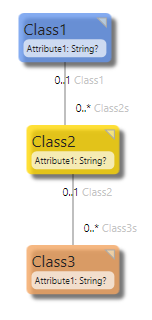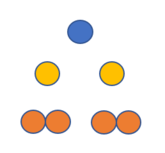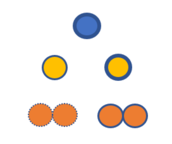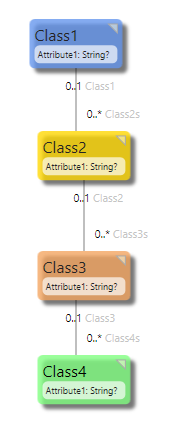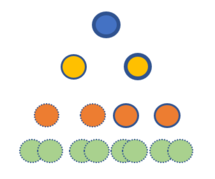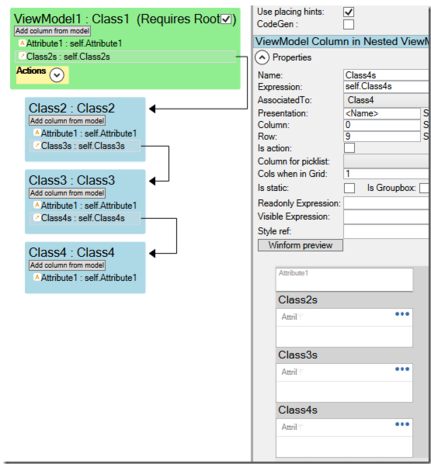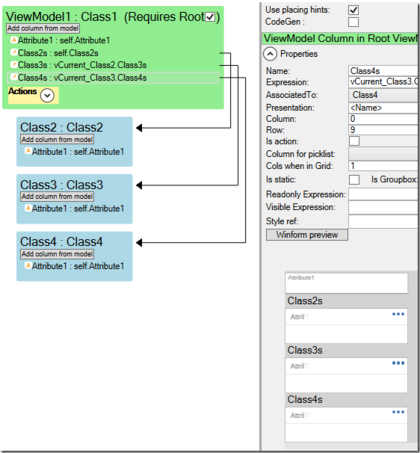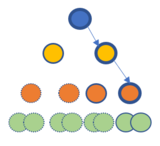(Created page with "There are two ways to look at object graphs used for defining ViewModels in MDriven. “Cursored” or “Full Tree” Consider this model: () Lets say we have 1 Class1 ob...") |
No edit summary |
||
| Line 5: | Line 5: | ||
Consider this model: | Consider this model: | ||
[[File:Cursored or Full Tree - Image 1.png|frameless]] | |||
Let's say we have 1 Class1 object that has 2 Class2 objects and for each Class2 object there are 2 Class3 objects. This would give us an instance diagram of actual objects like this: | |||
[[File:Cursored or Full Tree - Image 2.png|frameless|165x165px]] | |||
In MDriven you can build a ViewModel to show this information with nestings – lets say we build ViewModel rooted in 1 instance of a Class1 object – with a table of Class2 objects, and a master detail from each Class2 object to show the corresponding Class3 objects. This would be a good example of a “cursored” approach to handling the data. | In MDriven you can build a ViewModel to show this information with nestings – lets say we build ViewModel rooted in 1 instance of a Class1 object – with a table of Class2 objects, and a master detail from each Class2 object to show the corresponding Class3 objects. This would be a good example of a “cursored” approach to handling the data. | ||
| Line 15: | Line 15: | ||
What I mean with Cursored is that there is a cursor on the Class2 level that points to 1 of the Class2 objects and that this (pointing) decide which 2 of the total of 4 Class3 objects that will be visible: | What I mean with Cursored is that there is a cursor on the Class2 level that points to 1 of the Class2 objects and that this (pointing) decide which 2 of the total of 4 Class3 objects that will be visible: | ||
[[File:Cursored or Full Tree - Image 3.png|frameless|172x172px]] | |||
The objects with fat circle are the Cursors – there can be only 1 Cursor per level. The first level (the blue, the root) is given and will always be the root object. The Last/lowest level has nothing to cursor under it and can be neglected. The objects with dotted frame will not be onscreen/visible in a cursored view. | The objects with fat circle are the Cursors – there can be only 1 Cursor per level. The first level (the blue, the root) is given and will always be the root object. The Last/lowest level has nothing to cursor under it and can be neglected. The objects with dotted frame will not be onscreen/visible in a cursored view. | ||
| Line 25: | Line 25: | ||
Assume we introduce a class4 and give that 2 objects per owner of class3: | Assume we introduce a class4 and give that 2 objects per owner of class3: | ||
[[File:Cursored or Full Tree - Image 4.png|frameless]] | |||
[[File:Cursored or Full Tree - Image 5.png|frameless|215x215px]] | |||
If we are in a cursored view and we have the objects above – but we have not yet selected one of the class3 objects as the cursor – then we will not see any of the Class4 objects. | If we are in a cursored view and we have the objects above – but we have not yet selected one of the class3 objects as the cursor – then we will not see any of the Class4 objects. | ||
| Line 72: | Line 41: | ||
ViewModel for full tree strategy – giving access to all objects in UI and hence can show everything at the same time: | ViewModel for full tree strategy – giving access to all objects in UI and hence can show everything at the same time: | ||
[[File:Cursored or Full Tree - Image 6.png|frameless|464x464px]] | |||
ViewModel for Cursored strategy – to reduce what is loaded in advance and reduce what is available to a client side UI: | ViewModel for Cursored strategy – to reduce what is loaded in advance and reduce what is available to a client side UI: | ||
[[File:Cursored or Full Tree - Image 7.png|frameless|453x453px]] | |||
To get the Cursored approach in Turnkey we have “flattened” the Nestings from being 3×1 levels to being 1×3 level – lifting up the cursor variable to the root. | To get the Cursored approach in Turnkey we have “flattened” the Nestings from being 3×1 levels to being 1×3 level – lifting up the cursor variable to the root. | ||
| Line 82: | Line 51: | ||
What we have done by this maneuver is to go from this: | What we have done by this maneuver is to go from this: | ||
[[File:Cursored or Full Tree - Image 8.png|frameless|160x160px]] | |||
to this: | to this: | ||
[[File:Cursored or Full Tree - Image 9.png|frameless|176x176px]] | |||
Revision as of 06:40, 8 August 2023
There are two ways to look at object graphs used for defining ViewModels in MDriven.
“Cursored” or “Full Tree”
Consider this model:
Let's say we have 1 Class1 object that has 2 Class2 objects and for each Class2 object there are 2 Class3 objects. This would give us an instance diagram of actual objects like this:
In MDriven you can build a ViewModel to show this information with nestings – lets say we build ViewModel rooted in 1 instance of a Class1 object – with a table of Class2 objects, and a master detail from each Class2 object to show the corresponding Class3 objects. This would be a good example of a “cursored” approach to handling the data.
What I mean with Cursored is that there is a cursor on the Class2 level that points to 1 of the Class2 objects and that this (pointing) decide which 2 of the total of 4 Class3 objects that will be visible:
The objects with fat circle are the Cursors – there can be only 1 Cursor per level. The first level (the blue, the root) is given and will always be the root object. The Last/lowest level has nothing to cursor under it and can be neglected. The objects with dotted frame will not be onscreen/visible in a cursored view.
If we however do not want the cursored master detail – we can just as well look at the objects as a full-tree, meaning that all the objects may be available/visible at the same time.
Why is this important? As the depth of the graph grows (increase in levels/nestings) the different strategies (cursored or full tree) will deviate in possible optimizations.
Assume we introduce a class4 and give that 2 objects per owner of class3:
If we are in a cursored view and we have the objects above – but we have not yet selected one of the class3 objects as the cursor – then we will not see any of the Class4 objects.
The moment we do choose a class3 object – we will see the corresponding Class4 objects. It is ok for a level cursor to be null – or unpicked. The object graph above would have needed to load only 1 blue, 2 yellow and 2 orange objects – totaling to 4 objects.
If we look at the object graph from the full tree perspective we need to load 1 blue, 2 yellow, 4 orange, 8 green – totaling to 15 objects.
When using MDriven Turnkey – we implement the ViewModel with the VMClass and this use the full tree strategy. Using the full tree strategy makes it possible to build any UI-rendering on top of the ViewModel – like a tree that shows all the objects at the same time. Using legacy approaches with MDriven Framework the developer typically placed a Handle per level of the display tree and had a cursor-handle to keep the cursor object pointer.
It may be beneficial to use the cursored pattern even in Turnkey – to reduce objects needed to load – and it is easy to do with the MDriven declarative ViewModels by using the vCurrent_ variables on each level.
ViewModel for full tree strategy – giving access to all objects in UI and hence can show everything at the same time:
ViewModel for Cursored strategy – to reduce what is loaded in advance and reduce what is available to a client side UI:
To get the Cursored approach in Turnkey we have “flattened” the Nestings from being 3×1 levels to being 1×3 level – lifting up the cursor variable to the root.
What we have done by this maneuver is to go from this:
to this:

